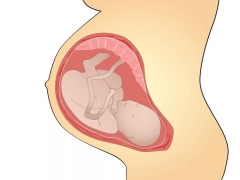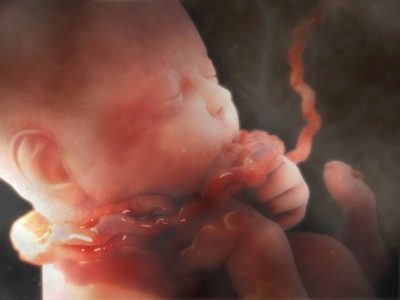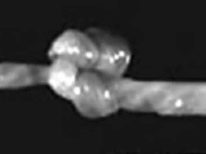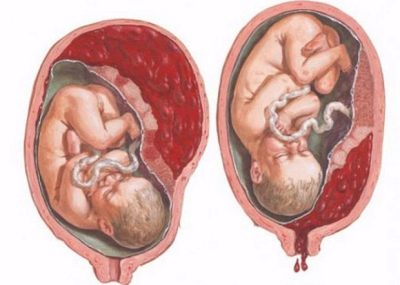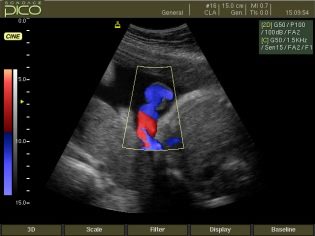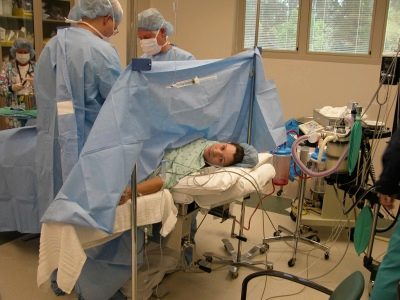Features of the effect of a short umbilical cord on pregnancy and childbirth
The state and characteristics of the development of the umbilical cord are important both for the process of carrying a baby and for the upcoming birth. The umbilical cord provides food, oxygen to the baby growing in the mother's womb. According to the vessels of the umbilical cord, the waste products of the child are brought into the maternal organism. What are the dangers of a short umbilical cord, we will tell in this article.
What it is?
The umbilical cord is a temporary organ, as is the placenta. It is necessary only in the period of carrying a child. In its structure, the umbilical cord resembles a hollow hose, one end of which is attached to the placenta, the other - to the front abdominal wall of the baby. Three vessels pass through the umbilical cord, two arteries and one vein. Vienna "supplies" the baby with blood enriched with oxygen and vitamins, and the arteries remove urea, carbon dioxide and other products of the baby's metabolism.
Normally, the length of the umbilical cord is 50-70 centimeters. Excessively long umbilical cord creates the danger of multiple entanglement, the occurrence of nodes. Short is the umbilical cord, the length of which is less than 50-40 centimeters. At the same time, an absolutely short umbilical cord stands out, the size of which was initially less than 40 centimeters, and a relatively short umbilical cord, which initially had a completely normal length, but became shorter due to knots, entanglement and for a number of other reasons.
Violation of the length of the umbilical cord is considered to be a fairly common pathology during pregnancy. The most common is the absolute form of violation, in which the dimensions are initially broken. Both types of short umbilical cord are considered to be rather dangerous in the first place as the probability of hypoxia in a child. But a relatively short umbilical cord associated with its mechanical entanglement or entanglement has more favorable predictions — it can unravel itself. An absolutely short umbilical cord has no such chances.
Causes
A shorter umbilical cord may be a hereditary factor. Often this pathology is detected in pregnant women who themselves were born with a short umbilical cord. The shortening of the umbilical cord is also often observed in women with pathologies of the placenta, which were formed at the earliest stage of laying the “children's place”. These are the main reasons for the development of an absolute short umbilical cord. The remaining predisposing factors in medicine are not yet obvious.
The relative short umbilical cord often develops as a result of entwining the umbilical cord of any part of the body of the crumbs. This can happen if a woman is undernourished, suffers from anemia, smokes or takes alcohol while carrying a baby. Chronic diseases, gynecological problems increase the likelihood of entanglement and shortening of the umbilical cord. Hypoxia of the fetus, which in its early stages causes an increase in the motor activity of the child, also increases the likelihood of entanglement.
Also, the cord shortens when nodes appear on it. Nodes can be true and false. True ones are associated with varicose expansion of one or several sections of the umbilical vessels, and false ones - with mechanical tightening of the nodule as a result of overlap of the cord or loop on it.The share of true nodes accounts for about 2-3% of all cases of shortness of the umbilical cord. Incorrect previa is also often the reason for shortening the binding child with the placenta of the cord.
Symptoms
A short umbilical cord cannot be determined by a woman on her own. This pathology does not present any tangible symptoms or inconveniences for the expectant mother during pregnancy. Most often the fact of a short umbilical cord is established already at birth. This is determined by the increase in the duration of the generic process. For women who give birth for the first time, the duration of labor with a short umbilical cord may increase up to 20 hours, and for women who come to the maternity hospital for the second or third time, up to 15 hours.
Short umbilical cord during childbirth is a danger as a factor in the probable abruption of the placenta ahead of time. When a child is born, it is normal to give birth to a child’s place for 20–50 minutes, but if the short umbilical cord pulls the placenta during the baby’s passage through the birth canal, an early detachment of the child’s place can occur, followed by massive bleeding.
Bleeding is dangerous in itself, but no less dangerous is the acute hypoxia, which occurs in the crumbs, if the “baby seat” has exfoliated prematurely. The consequences of such hypoxia can be tragic: the death of a child, irreversible changes in his central nervous system.
During pregnancy, the presence of a short umbilical cord may indirectly indicate the state of chronic hypoxia. However, it cannot be considered a true and indispensable symptom, because hypoxia can be caused not only by a short umbilical cord, but also by a host of other adverse factors and pathologies of pregnancy.
It is possible to establish the fact of hypoxia on CTG by the characteristic change in the heart rate of the baby, as well as by the changing nature of the movements. At the initial stage, the baby begins to move more actively, and when oxygen starvation is long-lasting, the frequency of movements of the child decreases significantly. It helps him save oxygen.
The state of the umbilical cord is studied using ultrasound, and the speed of the blood flow in it, the presence of nodes and the relative shortness can be determined by passing an ultrasound with a color doppler (ultrasound).
Diagnostics
Diagnosing a short umbilical cord is quite troublesome and difficult, pathology is difficult to recognize even with good ultrasound diagnostics equipment. If you suspect a short cord cord, the doctor must prescribe an ultrasound and USDG, but it is impossible to guarantee the absence or presence of pathology with a 100% probability. You can only make a presumptive diagnosis.
Ultrasound allows you to determine the presence of nodes, entanglement, but to measure the length of the cord using such an examination is not possible. If there are knots, a short umbilical cord may be suggested. USDG sets the speed, the intensity of blood flow in the umbilical vessels. In case of length violation, the presence of nodes and fetal entanglement, some violations of the blood flow velocity can also be recorded, but the diagnosis “short umbilical cord” cannot be made.
Cardiotocography (CTG) makes it possible to assess the baby's heartbeat, to pay attention to the conformity of his movements with contractions of the uterus muscles. In some cases, with obvious violations of CTG, the doctor may suggest a violation of the umbilical cord length, but this again does not mean setting an accurate diagnosis.
Only in isolated cases with a truly short umbilical cord pathology is determined by ultrasound (with a very small length of the cord). This allows you to predict the course of pregnancy, as well as to choose the correct delivery tactics, in order to exclude prolonged prolonged labor, placental abruption, fetal hypoxia and maternal bleeding.
The state of the umbilical cord for the first time is evaluated on the second planned ultrasound, previously this indicator is not considered informative.
Treatment
Despite the fact that every year medicine in the arsenal has new medicines and super-power modern equipment, it is impossible to treat a short umbilical cord. If a woman is told about the suspicion of such a pathology, doctors always recommend waiting tactics. If the survey does not show the presence of hypoxia in the baby, the woman can lead a normal life. She is advised to visit her obstetrician-gynecologist more often in the antenatal clinic.
If there is hypoxia or suspicion of it, then the pregnant woman is offered hospitalization in a specialized hospital. In-patient treatment will also be offered in the case of repeated cord entanglement. How long the treatment will last is difficult to say in advance. Some women under the supervision of a doctor have to stay until the birth. The scheme of maintenance therapy includes antispasmodics and vitamin preparations, light sedatives, iron preparations, magnesium and blood flow enhancers.
In the presence of hypoxia of the fetus, as well as the proven shortness of the umbilical cord, a caesarean section is prescribed in a planned manner. And this is the most favorable option, because surgical intervention eliminates the likelihood of placental abruption before the baby is born, as well as the likelihood of other complications during childbirth.
If the umbilical cord of a small length is discovered too late, that is, at birth, the team of obstetricians dissects the crotch of the woman in labor to make it easier for the baby to give birth.
During natural birth with a short umbilical cord, doctors constantly monitor the condition of the baby using CTG, taking readings every 30 minutes. If there is the slightest suspicion of hypoxia or other complications, signs of bleeding appear, the woman undergoes an emergency cesarean section.
Effects
A short umbilical cord during pregnancy is not as dangerous as in the process of childbirth. Prolonged labor threatens the occurrence of injuries of the pelvic organs, uterus, cervix, vagina. For the baby, a long and painful childbirth is also not the best way for the development of events, because he can begin to experience acute oxygen starvation.
Often children born with a short umbilical cord in a natural way with all the attendant complications lag behind in physical and mental development, they have problems with the development of speech, memory, they are more difficult to learn. CNS disorders that have developed due to acute traumatic hypoxia (for example, if the umbilical cord is torn off due to tension during labor or placental abruption) can have disabling effects.
After childbirth, there are no peculiarities in tying up the baby's umbilical cord. He cut the cord in a completely traditional way, the umbilical wound heals similarly to the wounds of other babies born with a umbilical cord of normal length. A short umbilical cord, contrary to popular belief, does not increase the likelihood of an umbilical hernia in a baby.
Prevention
Prevention of the shortness of the umbilical cord does not exist, because a woman cannot practically influence its length by any actions. But doctors recommend not to lose sight of the main and most common cause of anomalies - the hyperactivity of the fetus itself. In this regard, women who have just found out about their “interesting” position are advised to eliminate coffee, chocolate, cocoa from the diet as early as possible - such products “invigorate” not only the mother, but also the baby.
In order to exclude the entanglement and shortening of the umbilical cord, a woman should breathe more fresh air, lead a moderately active lifestyle, visit her doctor, without missing a single planned visit. A baby who receives enough oxygen and nutrients is much less likely to be entwined with an umbilical cord.
That is why it is important to give up bad habits, not to take any medications without the permission and approval of the doctor, not to contact with paints and varnishes, toxins and chemicals. It is important to stop being nervous. Whatever happens in the life of a pregnant woman, she must always remember that the experiences are temporary, and the health of the unborn child is almost constant, and much depends on the calm of the mother during gestation.
If a woman herself was born with a short umbilical cord, she should definitely talk to a geneticist at the planning stage of pregnancy. If pathology has already been discovered, do not panic - modern medicine has a sufficient arsenal to save the lives of mothers and babies without harming their health.
Pregnant women need to pull themselves together and trust the doctor - if he recommends a cesarean section, then he has good reason for this, and you should not resist.
For information on the causes and effects of the short umbilical cord, see the following video.
